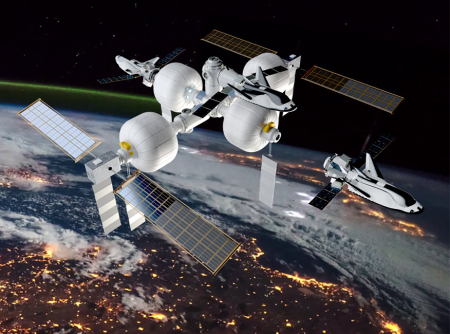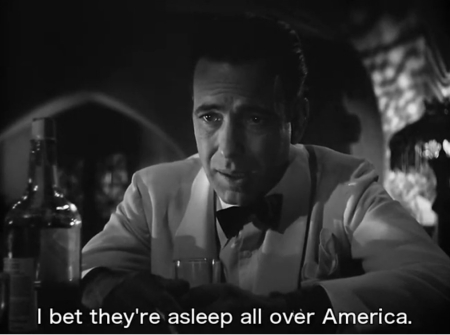April 2, 2021 Zimmerman/Batchelor podcast
Embedded below the fold in two parts
» Read more
Embedded below the fold in two parts
» Read more
Very brief descriptions, with appropriate links, of current or recent news items.
Embedded below the fold in two parts
» Read more

Regular readers of Behind the Black know that since 2018 I have regularly documented all the images of pits taken by the high resolution camera on Mars Reconnaissance Orbiter (MRO). (See my last pit post in January for a full list of these previous articles.) The black dots on the map to the right shows the location of all the pits near the volcanoes Arsia and Pavonis Mons that have so far been highlighted here.
The two white dots are the two most recent MRO pits, and are the subject of today’s cool image. They also happen to be the farthest north and south pits so far documented. The southernmost pit, which I am saving till last, is the most interesting.
» Read more

Burn witches: What the Southern Poverty Law Center
does to ordinary conservatives.
They’re coming for you next: The conservative David Horowitz Freedom Center and its publication FrontPage Magazine has found itself repeatedly blackballed by various major companies, simply because the center stands for freedom and the principles of western civilization.
In just the past couple of years, MasterCard temporally shut us down, one of our local banks closed our account due to our “controversial positions on issues,” and a brokerage firm closed our account for “unknown reasons.” Amazon will not allow the Freedom Center, a 501 c3 IRS designated nonprofit, to participate in their Amazon Smiles charity campaign because of the SPLC’s [Southern Poverty Law Center] designation of the Center has a “hate group” and now Disqus, the largest networked community platform on the Internet, has canceled our service.
The last example from Disqus involved that company’s sudden decision to cease providing the FrontPage website its commenting service.
» Read more

According to a JPL press release today, the seismometer on the Mars lander InSight detected two new 3+ magnitude quakes in March, both coming from the Cerberus Fossae region, the same region where the bulk of seismic activity has so far been pinpointed on Mars.
The map to the right was presented several weeks ago at the 52nd Lunar and Planetary conference, and could possibly include one of these two new quakes. The timing however of these March quakes is significant:
The new quakes have something else in common with InSight’s previous top seismic events, which occurred almost a full Martian year (two Earth years) ago: They occurred in the Martian northern summer. Scientists had predicted this would again be an ideal time to listen for quakes because winds would become calmer. The seismometer, called the Seismic Experiment for Interior Structure (SEIS), is sensitive enough that, even while it is covered by a dome-shaped shield to block it from wind and keep it from getting too cold, wind still causes enough vibration to obscure some marsquakes. During the past northern winter season, InSight couldn’t detect any quakes at all.
They are beginning to use the lander’s scoop to cover the seismometer and its communications tether with sand to protect both from the wind and temperature fluctuations. Once done they hope to be able to detect quakes during the entire Martian year, though this ability will be further limited by a reduction in power.
Despite the winds that have been shaking the seismometer, InSight’s solar panels remain covered with dust, and power is running lower as Mars moves away from the Sun. Energy levels are expected to improve after July, when the planet begins to approach the Sun again. Until then, the mission will successively turn off the lander’s instruments so that InSight can hibernate, waking periodically to check its health and communicate with Earth. The team hopes to keep the seismometer on for another month or two before it has to be temporarily turned off.
The new colonial movement: The science team for China’s Tianwen-1 orbiter are now targeting mid-May for when they will release and land the as-yet unnamed rover for its landing on Mars.
Wang Chi, director of the National Space Science Center at the Chinese Academy of Sciences, said March 23 that Tianwen 1’s lander and rover are scheduled to touch down on Mars in May.
“The first Chinese Mars mission, Tianwen 1, is now orbiting Mars, and we are landing in the middle of May,” Wang said in a presentation to the National Academies’ Space Studies Board. “We are open to international cooperation, and the data will be available publicly soon.” [emphasis mine]
Though China has generally released the scientific data of its lunar probes eventually, they have done it slowly. In the case of Tianwen-1, they released so far practically nothing, with the only images released being two hi-resolution ground images and a handful of distant global pictures of Mars.
An evening pause: Long time readers will recognize some images in this film taken from this earlier post.
And though the short film below is a silly April Fools video, it does contain one entirely true statement. Can you guess what it is?
Hat tip Jim Mallamace.

Doesn’t exist at MailChimp
They’re coming for you next: The email provider MailChimp has since the November election made it a clear policy to routinely cancel the accounts of conservatives if they dare send out any emails it deems politically incorrect.
In November MailChimp instantly disabled the email account of two tea party organizations, one in Virginia and the other in South Carolina, when they each tried to send out email notices to their members about post-election pro-Trump rallies.
In January MailChimp did the same to a conservative organization in California that was running a conference calling for the end of the overbearing lockdown rules imposed by the Democrat governor Gavin Newsom.
Because the ReOpenCalNow organizers are targeting a high level audience of policymakers, they assembled an email list of several thousand of California’s local elected officials. The list includes city council members, county supervisors, and members of school boards. Using MailChimp, they sent out three email blasts before receiving the following message:
“We received a direct complaint regarding a recent campaign sent from the account with the username ReOpen Cal Now. Direct complaints are serious because they indicate that a recipient contacted Mailchimp, our hosting facility, or a blocklisting agency about an unsolicited email.” The MailChimp email went on to say: “Because the content associated with your industry conflicts with our Acceptable Use Policy (mailchimp.com/legal/acceptable_use), Mailchimp is unable to serve as your email service provider and your account has been disabled.”
MailChimp went on to reject all appeals, and it is clear that the reason they would not reinstate ReOpenCalNow’s account was not because of spam. The laws protecting people from receiving spam do not apply to publicly available emails of elected officials. Every email on the list compiled by ReOpenCalNow were publicly available and corresponded to an elected official. [emphasis in original]
Today’s cool image focuses on one of the weirdest flow features I have yet seen on Mars. The first photo to the right, rotated and cropped to post here, comes from a January 27, 2021 picture by the high resolution camera on Mars Reconnaissance Orbiter (MRO). This cropped section focuses on the middle of three such weird features, two close flows heading downhill on the interior rim of very eroded 28-mile-wide crater. For some reason the flows also have depressions on their crowns. The depressions almost look like someone carved them out with a spackling spatula. In fact, the MRO science team agrees, labeling this image as “Spatulate Depressions with and without Upslope Gullies.”
The second image to the right shows a wider crop of the same picture, and explains the reason for the last half of that label.
» Read more
The photo to the right, taken yesterday, shows Perseverance’s Ingenuity helicopter now vertical with its legs deployed, hanging from the bottom of the rover and ready for placement on the ground.
The next step will be drop Ingenuity those last few inches. Once released Perseverance will quickly drive away, as it will no longer be providing power to the helicopter and will instead be blocking its solar panels from sunlight.
Perseverance will then proceed to its lookout post while engineers check out Ingenuity to make sure all is working.
The targeted flight date remains April 8th.
UPDATE: JPL just announced that it is delaying Ingenuity’s flight to April 11th. The announcement was done by a tweet, so provided no explanation as to why JPL decided to delay three days.

Artist conception of Sierra Nevada’s LIFE space station
Capitalism in space: Sierra Nevada announced today that it will not only build a manned version of its Dream Chaser reusable mini-shuttle, it now intends to use that shuttle as a ferry to its own space station, made up of inflatable modules.
They have dubbed their proposed station LIFE, and describe as follows:
The LIFE habitat is a three story, 27-foot large inflatable fabric environment that launches on a conventional rocket and inflates on-orbit. The LIFE habitat is undergoing a NASA soft-goods certification this year and the full size ground prototype developed under NASA’s NextSTEP-2 contract is in the process of being transferred from Johnson Space Center in Texas to Kennedy Space Center in Florida for further testing on short-and long-term habitation. SNC’s Astro Garden® system also provides fresh food within the habitat.
Making a manned version of Dream Chaser was always expected. Adding the company’s own station makes complete sense. Except for the rocket to launch a Dream Chaser spacecraft, Sierra Nevada will be able to provide a full service experience to, in, and from space.
The application to build a spaceport on one of the Shetland Islands has been rejected by a local monument authority because it would cause “extensive and adverse impact on the cultural significance” of a WWII radar station.
Mr Strang [head of the spaceport organization] said he was “greatly surprised” by the decision, claiming HES [Historic Environment Scotland] had “done nothing to preserve the site for the last 50 years”.
Skaw is the UK’s most northerly Second World War radar station and protected as a scheduled monument of national importance. The proposed space centre would be built almost entirely with in the RAF radar station site. It would require the removal of nine buildings, including air raid shelters, guard huts and those associated with the radar system. More than 200 archaeological features, such as foundations of buildings, gun emplacements and bomb craters would also be removed.
The Shetland Islands are very remote with few job opportunities for its residences. Putting a spaceport there seems like an excellent idea, especially because it will create hundreds of jobs where none exist now.
The radar facility did the same, but it did so more than seventy years ago, during World War II. Protecting these old and unused buildings for the sake of those long gone jobs seems utterly foolish.
The spaceport people say they will oppose this decision, but it is not clear from the article what they can do. The law as written appears to give this historical agency full power to veto.
They’re coming for you next: An industry group representing a number of big tech companies like Amazon and Google has written India’s governmental agencies that regulate broadband and space and demanded that they block SpaceX’s Starlink internet service in India.
An industry body representing the likes of Amazon, Hughes, Google, Microsoft and Facebook has written to the Telecom Regulatory Authority of India (Trai) and the Indian Space Research Organisation (Isro) asking them to stop SpaceX from pre-selling the beta version of its Starlink satellite internet services in India. It claimed SpaceX didn’t have licence or authorisation from the government to offer such services in the country. “We request you to urgently intervene to protect fair competition and adherence to existing policy and regulatory norms,” Broadband India Forum president TV Ramachandran said in the letters, seen by ET.
I could have filed this story under my series, “Today’s Blacklisted Americans”. These big tech companies have made it very clear in numerous earlier stories that they do not believe in competition or free speech. They are now demonstrating it again in India. Both Amazon and Hughes are direct competitors with Starlink. Neither also has a product that can compete with it (Amazon appears years from deploying its system and Hughes’ system has latency issues that make it much slower than Starlink). So, they team up with their leftist buddies Google, Microsoft, and Facebook to demand the Indian government do their dirty work for them, shutting down their competition.
It is unlikely that India’s Modi government, which is very much in favor of private enterprise, will do what these thugs want, but you never know. Politicians are like whores, they do what you pay them. If India does move to block SpaceX however I also expect there to be an outcry in that country, as it has many rural areas that can only be served by the kind of service Starlink is offering.
Embedded below the fold. This was a ten minute appearance to report on the Starship #11 test flight and the FAA’s apparent decision to increase its supervision on SpaceX testing.
» Read more

What Facebook & Instagram want cancelled.
They’re coming for you next: Both Facebook and Instagram instantly removed today an interview of former President Donald Trump in which he suggested he might run again for president in 2024, merely because the clip contained his voice.
[The interview] was for The Right View. … During the 18-minute interview, Trump also spoke about running for President again in 2024. Lara [Trump, whose show it was and who is Trump’s daughter-in-law] had been promoting it on Facebook, Instagram and Twitter beforehand.
At 9.26pm on Tuesday night, four minutes before it was due to be uploaded, Facebook emailed Lara’s team warning them that it would be removed if it went live. At 9.51pm, they emailed again to say that they’d taken it down.
Lara shared screenshots of the emails on Instagram afterwards. ‘And just like that, we are one step closer to Orwell’s 1984. Wow,’ she wrote alongside them.
Trump has been banned from Twitter, Facebook and Instagram since the January 6 riots, cut off from his supporters and unable to get messages to them in the way he did before.
In their email, the Facebook employee said that ‘content posted in the voice of President Trump is not currently allowed on our platforms (including new posts with President Trump speaking) and will be removed. ‘This guidance applies to all campaign accounts and Pages, including Team Trump, other campaign messaging vehicles on our platforms and former surrogates’. [emphasis mine]
The audacity of this censorship of a former president of the United States by these companies is breath-taking. The highlighted quote makes it clear: Their goal is to silence Trump, in every way possible. They do not celebrate free speech, or the ability of everyone to express themselves publicly. The only people who will be allowed freedom of speech will be those who agree with them.
Though they are private companies who should have the freedom to publish who they wish, these companies also have been granted special tax status as utilities which provide a platform for everyone, not a publisher who picks and chooses what he wishes to publish. Under this tax benefit, they have no right to block anyone’s show, period.
Putting aside these legalities, why would any Republican, conservative, or anyone who supports free speech remain a user of Facebook, Instagram, or Twitter? They are not only clearly Democratic Party operatives, working to promote that political party’s agenda, they also clearly view anyone who disagrees with that agenda to be pond scum. Why provide any support to such authoritarians?
According to new data obtained from the radar instruments on Mars Reconnaissance Orbiter (MRO) and Mars Express, scientists now think that the Medusae Fossae Formation, Mars’ biggest volcanic ash field and thought by some to be the source of most of the planet’s dust, might have an underground layer of ash that is also ice-rich. From their abstract:
The Medusae Fossae Formation (MFF) on Mars covers a vast area along the boundary between the rugged southern highlands and the smooth northern plains. While the MFF appears to be thick sediments or volcanic ash slowly eroding in the martian winds, how this material was emplaced remains mysterious. Most intriguing is evidence suggesting that some areas of the MFF may contain water ice. In this work we use sounding radar data from the SHARAD instrument on the Mars Reconnaissance Orbiter to probe up to 600 m below the surface and measure the electrical properties of the MFF material. The results suggest that the shallow parts of the MFF deposits are very porous and compress readily under their own weight. To match deeper probing by the Mars Advanced Radar for Subsurface and Ionosphere Sounding instrument on Mars Express requires a second layer of either vast porous deposits or ice‐rich material protected from sublimation by the dry sediments.
The MRO image above, originally posted here in November 2020, shows one example of the typical wind erosion found in the Medusae ash field. Apparently the ground-penetrating radar from orbit now suggests the possibility that there is an ash layer rich in ice, at depths beginning somewhere between 1,000 to 2,000 feet below the surface.
» Read more

Astronomers using the Chandra X-ray Observatory in orbit have for the first time detected X-rays coming from the planet Uranus.
In the new study, researchers used Chandra observations taken in Uranus in 2002 and then again in 2017. They saw a clear detection of X-rays from the first observation, just analyzed recently, and a possible flare of X-rays in those obtained fifteen years later. The main graphic [posted to the right] shows a Chandra X-ray image of Uranus from 2002 (in pink) superimposed on an optical image from the Keck-I Telescope obtained in a separate study in 2004. The latter shows the planet at approximately the same orientation as it was during the 2002 Chandra observations.
What could cause Uranus to emit X-rays? The answer: mainly the Sun. Astronomers have observed that both Jupiter and Saturn scatter X-ray light given off by the Sun, similar to how Earth’s atmosphere scatters the Sun’s light. While the authors of the new Uranus study initially expected that most of the X-rays detected would also be from scattering, there are tantalizing hints that at least one other source of X-rays is present.
One explanation could be that the X-rays could be coming from Uranus’s rings, as such X-rays do from Saturn. This is not confirmed as yet however. More data will be needed.
They’re coming for you next: The Federal Aviation Administration (FAA) announced today that it will “oversee” the investigation into the crash at landing yesterday by SpaceX’s eleventh Starship prototype.
The Federal Aviation Administration, which had an inspector at SpaceX’s facilities to observe the test flight, said in a statement that the FAA will oversee the company’s investigation into the “prototype mishap.” The FAA has conducted similar mishap investigations after previous Starship test flights. “The [Starship] vehicle experienced an anomaly during the landing phase of the flight resulting in loss of the vehicle,” an FAA spokesperson said. “The FAA will approve the final mishap investigation report and any corrective actions SpaceX must take before return to flight is authorized.”
The FAA noted that it will also work with SpaceX to identify reports of light debris in the area, saying that there have yet to be any reported injuries or damaged to public property.
What will really go on here is that an FAA official will observe closely as SpaceX conducts the investigation. That official might have some background in space engineering, but he or she will be completely unprepared to actually lead the investigation. Thus in the end the FAA will really only be able to rubber stamp SpaceX’s conclusions, though it might as all governments do, demand its own pound of flesh before issuing that stamp.
Up to now the FAA has tried very hard to work with the new commercial space companies, especially SpaceX, doing as little as it can to impede their progress. There are strong signs however that this might now change with the Democrats in control of the White House and Congress. If so, expect the FAA to cause SpaceX some grief during this investigation, grief that could significantly delay further test flights.
Capitalism in space: Three new German startup companies have joined the race to grab a share in the burgeoning new cubesat/nanosat launch business, with each building their own new rockets.
The companies are dubbed Isar Aerospace, Rocket Factory, and HyImpulse..
Each is developing rockets capable of carrying between 500 and 1,500 kilos (3,300 pounds) into low Earth orbit. While that’s a fraction of the tens of thousands of kilos hauled by the Falcon 9, operated by Elon Musk’s Space Exploration Technologies Corp., it’s enough to transport the satellites now being deployed for everything from super-fast Internet to autonomous driving.
Isar plans its first launch in ’22, HyImpulse in ’23. The target date of Rocket Factory’s first launch was not revealed.
These European companies join dozens such new smallsat rocket companies that already exist. Which will survive the shake-out that always occurs in such new industries only time will tell.
Capitalism in space: The last two passengers for the first entirely private commercial manned spaceflight, dubbed Inspiration4 and paid for by businessman Jared Isaacman, were announced yesterday, along with a launch date no earlier than September 15, 2021.
Isaacman bought the mission partly to fly in space, but also to raise money for St. Judes Children’s Research Hospital. Both Isaacman and Haley Arceneaux, a former St. Judes cancer patient, will fly. Their two new crew members are both experienced in aviation or spaceflight operations, though neither is a professional astronaut with any training in that field.
[Sian] Proctor describes herself as a scientist turned artist and an “analog astronaut” where people live in environments to simulate long-duration spaceflight. She has done four analog missions including NASA’s Hawai’i Space Exploration Analog and Simulation (HI-SEAS) Habitat to simulate a trip to Mars. She is a pilot, scuba diver, “and loves geoexploring our world.” Born in Guam while her father was working at a NASA tracking station there during the Apollo program, she has a B.S. in environmental science, an M.S. in geology, and a Ph.D. in Curriculum and Instruction: Science Education. She was a finalist in NASA’s 2009 astronaut selection.
While a U.S. Space Camp counselor, [Chris] Sembroski conducted simulated space shuttle missions and supported STEM-based education. He served in the Air Force maintaining a fleet of Minuteman III ICBMs and served in Iraq. After leaving the Air Force in 2007, he earned a B.S. in Professional Aeronautics from Embry-Riddle Aeronautical University. He now works for the aerospace industry in Seattle, although he did not specify what company.
Their spacecraft will be Resilience, the Dragon capsule that flew the first operational manned commercial crew to ISS, and is presently docked to the station. For the Inspiration4 flight however SpaceX is going to install a large domed window at the capsule’s nose, replacing the docking port that will not be needed.
China today used its Long March 4C rocket to successfully place another Earth observation satellite into orbit.
The article at the link also gives a short update on the status of China’s space station, with its first module Tianhe-1 presently scheduled for launch on April 29th, using their biggest rocket, the Long March 5B.
The leaders in the 2021 launch race:
9 SpaceX
7 China
5 Russia
2 Rocket Lab
The U.S. still leads China 13 to 7 in the national rankings.
Embedded below the fold in two parts.
» Read more

The new colonial movement: The United Arab Emirates (UAE) Al-Amal (Hope) Mars Orbiter has now reached its science orbit, and will begin its two years of observations (one full Martian year) of the Martian atmosphere on April 14th.
The photo to the right, cropped to post here, is part of a much larger image covering a good portion of the 600-mile-long fissures dubbed Cerberus Fossae and located Elysium Planitia, the vast lava plains located between the giant volcanoes Elysium and Olympus Mons, where most of the Martian quakes have so-far been detected by InSight. The context map below provides a wider context (the red boxes indicating high resolution Mars Reconnaissance Orbiter images). I think the area covered by this section of Al-Amal’s picture is near the western end of Cerberus Fossae.
The image was posted today in the image gallery for Al-Amal. Unfortunately there is no separate webpage for this particular post, so that link will take a long time to load, as apparently all the images there are large, not thumbnails. From their text:
On 15 March 2021, the Emirates eXploration Imager (EXI) captured a monochromatic image of the Cerberus Fossae, a fracture system that stretches for more than 1,000 km across the Martian surface, with a spatial scale of approximately 180 meters/pixel. The Emirates Mars Mission transitioned from the capture orbit to its science orbit with the successful completion of a 510-second burn of its thrusters. The Hope Probe is now in its final orbit of Mars and ready for its two-year science data gathering – the core aim of the mission. The science phase will commence on 14 April 2021.
The goal of Al-Amal is to study the atmosphere. This camera will provide wide shots, mostly for the purpose of observing the coming and going of cloud features. Nonetheless, this is a nice wide view of Mars.

What this academic wants cancelled.
They’re coming for you next: In complete ignorance of the free speech’s most basic principle — not to give the government or any ruling body veto powers over anyone’s speech — the head of the digital journalism center at Columbia University, Emily Bell, recently demanded exactly that, calling for the government and news media to tighten its rules to restrict speech at conservative news organizations.
Bell was testifying at a House hearing engineered by Democrats to encourage such censorship.
Bell said that the unprecedented events of 2020 and 2021 coincided with “widespread and often politized information” on “conservative cable news channels” and that local reporters need to “learn new cadence.” She added that the country needs to “rethink what public broadcasting is in the digital age” and “apply some pressure to the platform companies to allow much greater auditing.”
While she had couched her words carefully, there was no mistaking her meaning. She wants the government, the media, and the big social media platforms to work together to silence any conservative opinions she dislikes.
I would give her the benefit of the doubt and consider her merely sincere and naive, someone who simply wants to stop misinformation in the press, except that the only misinformation she identifies is connected with conservatives and conservative protests. Somehow the bad reporting in connection with the rioting by Antifa and Black Lives Matter, designed to hid their violent and rebellious nature, seemed perfectly okay with her. Nor was she apparently bothered by the effort of the mainstream press and the big tech companies like Twitter and Facebook to censor all mentions of corruption by Biden and his son Hunter, prior to the election.
To put it bluntly, Bell is a typical leftist academic, partisan to her bones and eager to smash her boot into the face of anyone with whom she disagrees. And her goal is to smash that boot into the face of all conservatives, now and forever.
Though by law NASA and the scientists cannot exchange data or communications with China due to security concerns, NASA and Chinese officials did exchange communications recently in order to coordinate the orbits of their orbiters presently circling Mars.
Jurczyk noted that NASA’s knowledge of China’s space program is largely limited to publicly available information because of restrictions placed by federal law on its interactions with Chinese organizations. Those restrictions do allow NASA to engage with China if approved by Congress. “Most recently, we had an exchange with them on them providing their orbital data, their ephemeris data, for their Tianwen-1 Mars orbiting mission, so we could do conjunction analysis around Mars with the orbiters,” he said.
In a brief statement to SpaceNews late March 29, NASA confirmed it exchanged information with the China National Space Administration (CNSA), as well as other space agencies that operate spacecraft at Mars. “To assure the safety of our respective missions, NASA is coordinating with the UAE, European Space Agency, Indian Space Research Organisation and the China National Space Administration, all of which have spacecraft in orbit around Mars, to exchange information on our respective Mars missions to ensure the safety of our respective spacecraft,” the agency said. “This limited exchange of information is consistent with customary good practices used to ensure effective communication among satellite operators and spacecraft safety in orbit.”
Such limited communications are actually permitted under the law that Congress passed, as long as they do not involve any exchange of technical information. There has been a push, however, in the planetary community for years to increase direct communications with China, allowing the transfer of all kinds of information, both scientific and technical. Until the law gets changed none of this should happen.
Of course, what matters laws these days? I will not be surprised if the Biden administration, rather than demanding a change in the law, instead begins expanded communications between NASA and China, in complete and utter contempt for the law, with no one objecting.
The Biden administration has announced that it will continue the National Space Council, restarted during the Trump administration.
The new council will of course be made up entirely of Biden appointees, just as the Trump council was made up of Trump appointees, and will like the Trump council merely be a loudspeaker for space policies that the Biden administration wants established. There will be little continuation of policy. In fact, the new council, made up of Democrat politicians, will likely work to end the policies created during the Trump administration.
My cynicism here of the Biden administration should not be construed as support for the council under Trump. After watching the first session of the council under Trump I concluded it was nothing more than a vehicle for Trump propaganda, and therefore not worth getting much attention.
They’re coming for you next: The Democratic Party leaders on the House committee that normally does not overseer the FAA’s commercial space office have now raised their concerns about the recent test flights of SpaceX’s new rocket, Starship, in particular demanding an investigation into the flight of prototype #8, which the FAA claims had occurred despite one FAA issue.
The latest version of SpaceX’s FAA launch license for the Starship suborbital test flight program, issued March 12, allows those test flights to take place “only when an FAA Safety Inspector is present at SpaceX’s Boca Chica launch and landing site.”
The change stemmed from an investigation into SpaceX’s violation of that launch license during the SN8 test flight in December. SpaceX proceeded with the flight despite the FAA determining that the flight profile exceeded the maximum allowed risk to the uninvolved public for “far field blast overpressure” in the event of an explosion. While the SN8 vehicle exploded upon landing, there were no reports of damage outside of the SpaceX test site.
FAA directed SpaceX to investigate the incident, delaying the flight of the next Starship prototype, SN9. That investigation included “a comprehensive review of the company’s safety culture, operational decision-making and process discipline,” the FAA said in a Feb. 2 statement.
The FAA cleared SpaceX to proceed with launches, with SN9 and SN10 launching and landing — and both exploding upon or shortly after landing — on Feb. 2 and March 3, respectively. Neither caused any damage outside of the SpaceX test site.
The FAA’s response to SpaceX’s launch license violation, including the lack of any penalties beyond the investigation, prompted criticism from two key members of Congress. In a March 25 letter to FAA Administrator Steve Dickson, Reps. Peter DeFazio (D-Ore.) and Rick Larsen (D-Wash.) sought to “register our concerns” with the incident. DeFazio is chair of the House Transportation Committee and Larsen the chair of its aviation subcommittee.
Much of these claims about the flight of prototype #8 however only appeared to become a significant concern after the Biden administration and the Democrats took power in January. Prior to that the FAA did not seem very troubled by that flight. In fact, the so called risk, “far field blast overpressure,” seems very contrived, especially since we have now had four Starship crashes on its landing pad, with no evident damage to even SpaceX’s own equipment nearby. Prior to January 20th the FAA was untroubled. After January 20th it suddenly became a deadly issue requiring stricter supervision by the government, though what that FAA inspector on sight can do or even know about the launch is baffling.
What these Democrats really don’t like is that someone is freely accomplishing something without their supervision or control. Like mobsters looking to exhort money, they are essentially telling SpaceX, “Nice business you got here. Sure would be a shame if something happened to it.”
With today’s fourth Starship crash, expect the Demorats in Congress now to swarm like flies over manure, all aimed at shutting down the most innovative new American space company in decades.
Capitalism in space: The fourth prototype of Starship to fly, #11, experienced another failure at landing early this morning, crashing onto its launchpad.
Below is SpaceX’s live feed, cued to begin at T-10 seconds. The video cuts out at T+5:49, just before landing. I have reviewed other live feeds and all that I can find so far were obscured by the cloudy conditions at landing.
Musk later tweeted the following:
‘At least the crater is in the right place!”
“Looks like engine 2 had issues on ascent & didn’t reach operating chamber pressure during landing burn, but, in theory, it wasn’t needed. Something significant happened shortly after landing burn start. Should know what it was once we can examine the bits later today.”
The next Starship prototype will be #15 (numbers 12-14 pulled when they decided to redesign based on the earlier flights).

Cool image time! In the March 1st image release from the high resolution camera on Mars Reconnaissance Orbiter (MRO) were two pictures covering sections of the interior rim of 40-mile-wide Renaudot Crater, located in the northern lowland plains of Mars north of the region I dub Mars’ glacier country.
The map to the right provides the context. The two red boxes in Renaudot Crater show the location of the two images below, with the first being the one to the left. Located at about 42 degrees north latitude, we should expect to see evidence of ice and glacial features here, and that is exactly what both photos show.
» Read more
They’re coming for you next: The new California ethnic studies program that is expected to be imposed on all the state’s classrooms is in fact based entirely on critical race theory (CRT) that makes whites the devil and all other minorities its victims, except Jews, who are targeted for special condemnation using language reminiscent of Nazi Germany.
Because of outrage over the bigoted nature of the earlier versions, two revisions have been offered, both of which really changed nothing of substance. The last version however added the following:
Two lessons have been offered about Jews. One, following crude CRT dogma, teaches that Mizrahi Jews coming to the United States from Arab lands were mistreated by “white” Ashkenazim. The other suggests that Jews of European descent have white privilege.
The Jewish Journal points out that Jews are the only group in the curriculum for whom the term “privilege” is used. And this privilege is not earned by way of talent, or educational and professional attainment, but rather trickery. The ESMC, echoing Nazi propaganda about Jews as impostors and appropriators hiding in plain sight, points out that American Jews often change their names (“this practice of name-changing continues to the present day”) to change their rank in the social hierarchy.
The historical reality of repeated genocidal attacks on Jews because of their perceived or imagined privilege is not offered as counterpoint, because ethnic studies teachers assume the Holocaust is taught in world history class. But next year in San Mateo County, world history will be replaced by ethnic studies.[emphasis in original]
There is a lot more in the article at the link. Overall it outlines the racist, white- and Jew-hating nature of critical race theory, about to be imposed on all students in California’s public school system, even as that system removes any teaching about world history and the Nazi genocide of millions of Jews.

Click for video.
Note that while this program is being created by the bigoted idiots in the state’s various ethnic studies programs, it was mandated by the state’s Democratically-controlled legislature and signed into law by the previous Democratic governor, Jerry Brown, and later endorsed by the present Democratic governor, Gavin Newsom.
If you live in California, you voted for this, either from apathy, ignorance, or maybe even your own bigoted motives. And while one would expect Californians to be horrified and ashamed by this, I fully expect more apathy and ignorance, even as the bigots gain more power.
As I say, they’re coming for you next. And I fear that few decent people are doing anything to stop these thugs.
It was always about power: A review of 87 regions worldwide has now found that the lockdowns imposed in panic in the past year did nothing to slow COVID, while contributing massively to economic devastation and increased mortality associated directly to that devastation.
Both a restrictive and global analysis were performed in the study. In the restrictive analysis, direct comparison of two regions took place if three of the four following conditions were similar: population density, percentage of urban population, human development index, and total area of the region. The global comparisons included regions and countries worldwide.
In the restrictive analysis, only one comparison (or 3 percent)—between the state of Roraima, Brazil, and the state of Rondonia, Brazil—was significant, while in the global comparisons, only 1.6 percent were significantly different. “Indeed,” the researchers wrote, “the global comparison confirmed the results found in the restrictive one; only 1.6 percent of the death rates could be explained by staying at home.”
Put another way, in about 98 percent of the comparisons, there was “no evidence that the number of deaths/million is reduced by staying at home.” The findings were backed up by real-world examples taking place at the time.
Even if this study had found that there was a five percent reduction in COVID deaths resulting from lockdowns, that number would not have justified the damage done to lives, businesses, and the health of millions because they were trapped in their homes, could not work, or see their doctor for other health concerns.